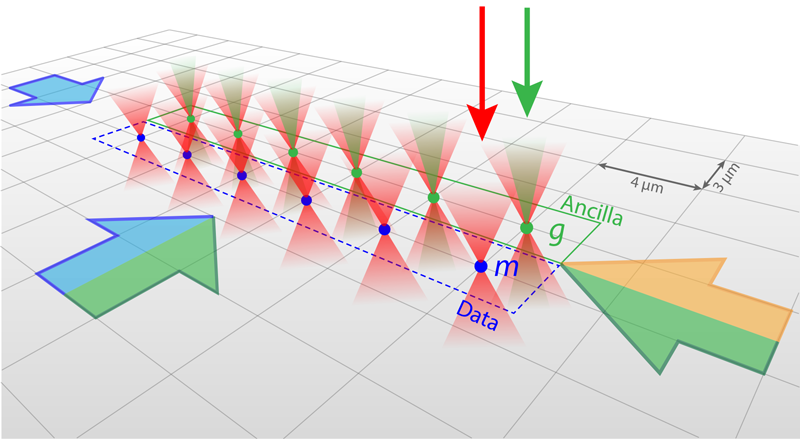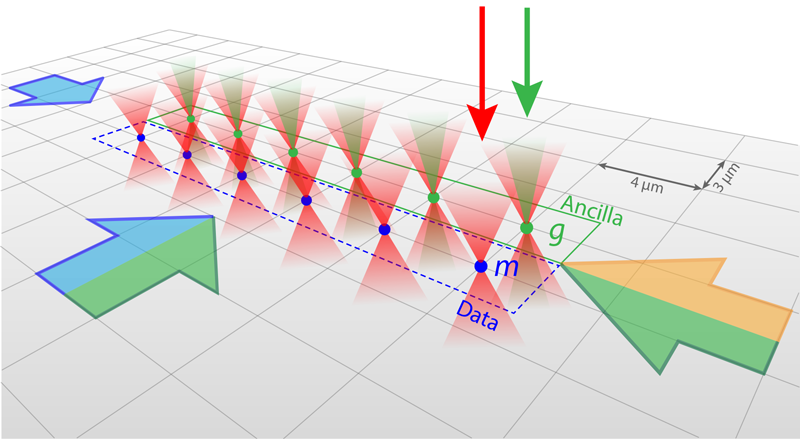Midcircuit Operations in Atomic Arrays
Quantum computing on neutral-atom platforms has reached remarkable milestones in the past two decades. However, researchers have yet to overcome a key barrier to the realization of a neutral-atom-based quantum computer: the efficient correction of errors. In principle that barrier can be lowered with so-called midcircuit operations. These operations involve probing the quantum state of “ancilla” qubits without disturbing nearby “data” qubits used for computation. The ancilla qubit measurements can indicate whether the data qubits have undergone faulty operations, allowing for the data qubits to be corrected midcircuit—that is, during the execution of the computation rather than after its completion. Now three independent research groups have achieved midcircuit operation, or made progress toward this goal, with a novel choice of atom: ytterbium-171 (171Yb) [1–3].
A neutral-atom qubit platform consists of a two-dimensional (2D) array of atoms trapped by optical tweezers—tightly focused laser beams whose wavelengths are tuned far away from the atomic transitions. The size of the traps, limited by diffraction, is typically about 1 µm. Thanks to the large electric-dipole force from the focused laser and to a high vacuum, the atoms can stay trapped for as long as tens of seconds.
Early developments of neutral-atom platforms advanced mainly on two fronts: developing scalable tweezer arrays [4] and improving the fidelities of the quantum gate operations. The creation of large tweezer arrays with 2D acoustic-optical deflectors or spatial light modulators has enabled schemes that load atoms to completely fill a subset of the array that can be deterministically addressed [8, 9]. High-fidelity gate operations are obtained through the precise control of the laser and the microwave pulses used to manipulate the internal spin states of the atoms [5–7].
If large-scale, universal quantum computing is to be realized, the current high fidelities of gate operations of 99%–99.99% need to be improved even further with error-correction schemes. In most such schemes, the measurement of a redundant ancilla qubit indicates if the data qubit has undergone a faulty spin flip. For an ancilla qubit to perform this role, the measurement of its state must be spin selective and spin preserving, and it should not disturb the quantum coherence of the data qubits.
Until five years ago, quantum computing experiments with neutral atoms used alkali metal species whose qubit states were encoded in hyperfine substates of the atoms’ electronic ground states. The qubit state is usually measured by the state-selective removal of the atom from the tweezer followed by a state-independent measurement that detects the atomic fluorescence. This method suffers two main drawbacks. First, because the qubit is removed, atoms have to be reloaded before the next operation. Second, the absence of fluorescence is ambiguous: it can’t differentiate between the qubit being in the off state and the atom having escaped from the tweezer.
Realizing midcircuit measurements that don’t involve removing atoms would circumvent the drawbacks. With that goal in mind, researchers have been working with qubits based on rare-earth atoms such as Yb. Those efforts have now paid off. A team from Atom Computing in California led by Ben Bloom has demonstrated midcircuit qubit-state measurement on 171Yb arrays [1]. A second team from the University of Illinois at Urbana-Champaign (UIUC) led by Jacob Covey has used a similar approach to perform repetitive measurements on the qubit states—a scheme that could soon achieve midcircuit capabilities [2]. A third team from JILA at the University of Colorado Boulder led by Adam Kaufman has also realized midcircuit qubit operations harnessing a so-called clock transition of Yb [3].
Neutral Yb atoms have two valence electrons paired in a closed shell, so the ground state has a total electronic angular momentum of zero. However, the nuclear spin splits the ground state into two sublevels, which can be used as two qubit states. Unlike alkali atoms, Yb isotopes offer different electronic transitions from the ground state with a wide range of strengths. The strongest one is used to load atoms into the array. The weaker “intercombination” transition is used for narrow-line cooling and imaging. A third transition, with an extremely narrow, sub-Hz linewidth, has proved suitable and successful for ultrastable optical clock metrology [10].
In the experiments of both the Atom Computing and UIUC groups, the energies of the two qubit states were shifted in opposite directions via the Zeeman effect induced by an applied magnetic field. The magnetic sublevels of the upper state, which is connected to the ground state by the imaging transition, have Zeeman shifts more than 1000 times as large as that of the nuclear spin in the ground state because of the large contrast of the gyromagnetic ratio of electronic and nuclear spins.
The Atom Computing experiment applied two laser beams of opposite circular polarizations resonant with the two qubit states’ transition frequencies. The combination of opposite polarizations and large Zeeman shifts isolated the optical measurements of the two qubit states. The optically excited atoms always decayed to the initial qubit state during the fluorescence imaging, which ensured the qubit-state measurement was state selective and state preserving. What’s more, the Atom Computing experiment realized site-selective measurement via the application of an additional laser-beam array, preventing the data qubit states from being affected by the measurement beams. During the ancilla qubits measurements, the coherence of the data qubits decayed by only 2.5%, and occasional ancilla qubits lost during measurements could be refilled from an outer reservoir array.
By contrast, the UIUC experiment used a measurement beam with random polarization—implying the scheme had no polarization selection. However, since the frequency of this beam matched the transition between only one of the qubit states and only one of the substates of the upper state, they could measure deterministically and with spin selectivity one of the qubit states. Repeated qubit-state measurements showing the same result verified that the measurement was also spin preserving. To upgrade the UIUC apparatus for a midcircuit measurement, further work needs to be done to measure both spin states while protecting the data qubits from the measurements.
In the JILA group’s work, the researchers incorporated Yb’s optical clock state into the quantum operations. Since the clock state lives longer than one second, atoms could be “shelved” in the clock state while the other atoms underwent fast quantum operations in the ground state. A spin-selective experiment transferred one of the qubit states from the ground state to the clock state, followed by the imaging of the other qubit state in the ground state. The absence, or presence, of fluorescence during imaging corresponds, respectively, to the qubit state being shelved or not. Based on the result of this measurement, the scheme controlling the operations obtained knowledge of the qubit state before shelving and imaging it. This work also demonstrated high fidelities of gate operations for three cases of qubit-state encoding (involving, respectively, the two nuclear spin substates in the ground state, the two nuclear spin substates in the clock state, and one of the substates in the ground state and one of the substates in the clock state). The case involving the clock state qualified as a midcircuit measurement because the shelving process was site selective and the imaging of the ground state did not disturb the atoms in the clock state. These quantum implementations with the clock state will facilitate other tasks, including quantum error corrections, entanglement generation, and quantum precision measurement.
These advances in midcircuit measurement constitute an important milestone toward accomplishing flawless gate operations with quantum error correction. Future research may explore other atomic platforms, as midcircuit measurement is not confined to rare earths. Recently, for instance, a group demonstrated midcircuit measurements in an array of neutral alkali atoms—cesium—by shelving data qubits in hyperfine-Zeeman substates [11]. Another important direction will involve increasing the qubit-state coherence time. A single qubit measurement on the neutral-atom platform still typically takes 10 ms. Thus, the qubit coherence time will need to be sufficiently long to allow for multiple measurements to be performed within the computation window.
References
- M. A. Norcia et al., “Midcircuit qubit measurement and rearrangement in a 171Yb atomic array,” Phys. Rev. X 13, 041034 (2023).
- W. Huie et al., “Repetitive readout and real-time control of nuclear spin qubits in 171Yb atoms,” PRX Quantum 4, 030337 (2023).
- J. W. Lis et al., “Midcircuit operations using the omg architecture in neutral atom arrays,” Phys. Rev. X 13, 041035 (2023).
- D. Barredo et al., “Synthetic three-dimensional atomic structures assembled atom by atom,” Nature 561, 79 (2018).
- T. M. Graham et al., “Rydberg-mediated entanglement in a two-dimensional neutral atom qubit array,” Phys. Rev. Lett. 123, 230501 (2019).
- H. Levine et al., “Parallel implementation of high-fidelity multiqubit gates with neutral atoms,” Phys. Rev. Lett. 123, 170503 (2019).
- B. Nikolov et al., “Randomized benchmarking using nondestructive readout in a two-dimensional atom array,” Phys. Rev. Lett. 131, 030602 (2023).
- D. Barredo et al., “An atom-by-atom assembler of defect-free arbitrary two-dimensional atomic arrays,” Science 354, 1021 (2016).
- M. Endres et al., “Atom-by-atom assembly of defect-free one-dimensional cold atom arrays,” Science 354, 1024 (2016).
- A. D. Ludlow, “Optical atomic clocks,” Rev. Mod. Phys. 87, 637 (2015).
- T. M. Graham et al., “Midcircuit measurements on a single-species neutral alkali atom quantum processor,” PRX (to be published) (2023), arXiv:2303.10051.





